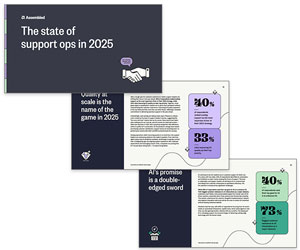Resource planning is at the heart of every successful contact centre, as it ensures the right people are in the right place at the right time to meet customer demand, while balancing efficiency, service levels, and employee well-being.
As operations grow more complex with new channels, shifting customer expectations, and evolving workforce needs, planning can quickly become a challenge. Yet despite these changes, the foundations of good resource planning remain the same.
In this article we take a look at the fundamentals of resource planning, highlight what might go wrong and then focus on the tools and techniques that you need to know.
The Basic Principles of Resource Planning
The first thing that we need to do when thinking about resource planning is to go back to the basics and understand each individual area and its interdependencies with other areas.
All too often we look to the many technology-based solutions that are out there without understanding some of the key principles that underpin what we are doing.
This is according to John Casey, a Resource Planning Expert at CCplanning, who presents the following model of the planning cycle to highlight that the fundamentals have not changed for decades.
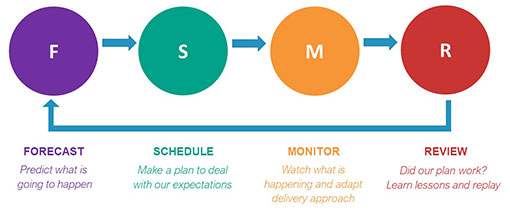
Despite the growing number of channels and various new techniques in each of these core areas, this cycle has not changed.
We therefore need to be confident in our processes and have a clear understanding of the below:
Forecasting
This involves predicting how many contacts we will handle, using historical data and considering other internal and external factors to do so.
Scheduling
With our forecasts, we then want to calculate the right number of advisors to meet the predicted demand, while also meeting occupancy and service level targets. With this number, we map staff against our chosen shift patterns.
Monitoring
Monitoring involves judging the success of our forecasts and schedules in real time, so keeping an eye on real-time metrics – like service level, queue time, abandon rate, etc.
Review
Then we need to take the time to step back and understand what happened to our plan. What could we do differently? And what do we need to try as we move forward?
In each of these areas things can go wrong; things happen such as advisors phoning in sick, which means we can meet the demand that our plan fails.
But an experienced resource planner is fully prepared and builds all these unfortunate eventualities into their plan. They know where contact centre planning can go wrong…
Resource Planning Tools and Techniques That You Need to Know
While you will not need any particular tools or techniques for the final, review, stage of the resource planning cycle, the three prior stages do need specialist tools and techniques.
For those who are lucky enough to have a sophisticated workforce management (WFM) system in place, you may not need to follow all of the below advice.
However, if you do not, these following tools and techniques are vital to be aware of and use, in order to become a good resource planner, specifically on the phone channel.
For Forecasting
The most basic method for contact centre forecasting on the voice channel is called “triple exponential smoothing”, which can be used with just 3–5 years of call data.
This method has been used in contact centres since the 1960s and it looks at three elements of your call data to make a prediction of future call volumes. These three elements are: level, trend and seasonality.
While there are many more methods for forecasting, including the ARIMA method, neural networks and Multiple Temporal Aggregation (MTA), triple exponential smoothing remains popular. This is due to its practicality, with many contact centres using this method and Microsoft Excel.
For more about triple exponential smoothing and these other forecasting methods, read our article: The Latest Techniques for Call Centre Forecasting
For Scheduling
With your predicted call volumes, which you will ideally break down into hourly periods (at most) across the day, it is then traditional to use an Erlang Calculator to calculate how many advisors you need to meet the demand for that time period.
To use an Erlang Calculator you need to enter the following information:
- Predicted contact volume
- The length of time over which you expect to receive that contact volume
- Your target service level
- Your target queue time
- Your target occupancy rate (no more than 85%!)
- Your average patience
Once you have estimations for the number of advisors you need across the day, you can map staff against shift patterns, remembering to use the latter as an opportunity for employee engagement.
To find out all of the various shift patterns that contact centres choose to use, read our article: The Best Shift Patterns for the Contact Centre
For Real-Time Monitoring
To monitor metrics such as service level, average speed of answer (ASA) and abandon rate in real time, you will need a specialist dashboard, which feeds back each of these statistics and more.
With easy access to this dashboard, you, as the resource planner, not only have all the information that you need to take control of spikes in contact volumes across the entire contact centre, but you can also better manage cross-channel demand.
To manage this, you can quickly find out if advisors on one channel may be struggling and if those on others are not. If this is indeed the case, you might be able to move advisors across channels to better deal with the situation – so long as they are multiskilled.
To find out more about monitoring, read our article: 17 Resource Planning Tools and Techniques You Should Know
X Ways Resource Planning Can Fail
Below we take you through the most common failures in each of the four areas of the planning cycle and share some advice for avoiding them.
1. Unrealistic Forecasts
We have got to prepare for what might happen. For example, in the UK it is rare for there to be heavy snowfall that significantly impacts both your contact volumes and the ability of advisors to get into work.
However, in February, snow and ice caused delays to road, rail and air travel, which meant that many contact centres across the country suffered from both of these issues.
The previous February months had seen very little snowfall. So would planners have been thinking about this uncertainty?
This is a lesson that we shouldn’t just be guessing what might happen and make a forecast that’s based on a single estimation. To be fully prepared, we need to be making multiple forecasts, and this is where a lot of resource planners slip up, according to John Casey.
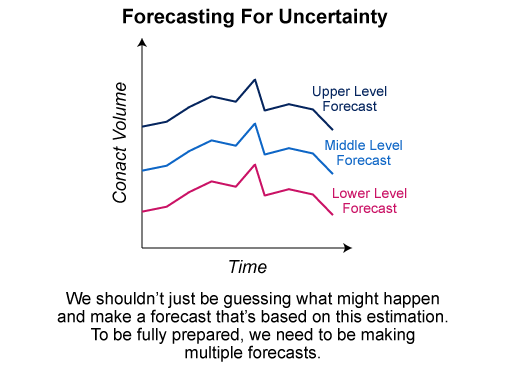
John says: “It’s good to make upper-, middle- and low-level forecasts that say: if this happens in the world and that happens, why would customers then want to contact us?
We can then schedule to the most likely forecast when we have more information and provide back-up options for the other scenarios.”
These tricky and foreseeable events will not only impact contact volumes, but your Average Handling Time (AHT), which will impact the next stage of our process: scheduling.
To find out how to create a contact centre forecast, read our article: A Guide to Workforce Forecasting in the Contact Centre
2. Unrealistic Schedules
Now, more than ever, with demographics changing in our workforce, the first question that we need to be asking when it comes to resource planning is: do we understand what our staff want?
Sometimes staff just don’t want full-time hours as it interferes with their life, so an increasing number of people are just looking for a baseline number of hours to work a week.
More team members than you would likely imagine will tell you that they would ideally only work 25 or 30 hours a week. But if they’re at a loose end one week, they will likely be happy to pick up an extra shift.
However, we are often guilty of pocketing people into this full-time 35–40-hour week, which they do not necessarily want.
So, by not understanding and meeting our team’s scheduling desires, when they see another job with better hours and greater flexibility, we lose advisors through attrition and absenteeism.
This negatively impacts our planning cycle, so we need to start thinking of scheduling as an employee engagement opportunity and build an expected percentage of absenteeism into our schedules.
In addition to this, We also need to think about whether our schedules match the needs of our customers. Are we open when they expect us to be open? Why do we have the spikes and drops in contacts throughout the day?”
“With scheduling, it’s not just relying on the software to give us the graphs and numbers, but going back and actually asking ourselves those questions allows us to manipulate some of the data and better plan going forward.”
To understand how to build schedules around your forecast contact volumes, read our article: How to Work Out How Many Staff You Need In a Contact Centre
3. Unneeded Reaction
As a resource planner, there is a great skill in knowing when we should hold our nerve.
It’s easy for us to see 20 calls waiting and think “we must do something”. Maybe then we would start to cancel breaks or training, but that’s dangerous, because if somebody sees that, there will be panic and advisors may not be able to perform to their best ability.
But sometimes we’ve planned for that, we’ve planned to be busy. Perhaps we knew that we were short on staff and that was exactly what was in our plan.
So sometimes we just have to hold it. We know that things will settle down when the next group comes back from their break.
While we need to do real-time monitoring and react in certain situations, knowing when we need to react or step back to take a breath and say, ‘give it four or five minutes more and then we’ll put our emergency plan into place’ is a key skill.”
Reacting too quickly can as easily create a problem where none existed – short-duration volume deviations are to be expected and can sometimes vanish as quickly as they arrive.
In time, you will most likely develop this skill as a resource planner, but it wouldn’t harm to have different levels to your emergency plan to match the severity of the issue.
4. Improper Review
When it comes to the final stage of the resource planning cycle, we need to ask ourselves two questions:
- Do we have time to analyse?
- Can we analyse what has happened without bias?
All too often we hear someone saying, “We were busy yesterday because…” and we run with it, we run with these assumptions and ignore real issues.
In terms of being an analyst, we can only do that job well when we remove all bias. While it can be all right to make assumptions, don’t go looking for things.
John adds: “All too often I hear things like ‘There was a little bit of sickness today and that’s why we were busy’ and we take that at face value.”
“But maybe we planned for the wrong levels of absenteeism or maybe we lowered holiday allowance and we overlooked that fact. So, we do need to maintain a very open mind throughout the review process.”
What Often Gets Missed When Resource Planning
One key point that we often miss when it comes to resource planning is our trouble with averages. They are a planner’s worst enemy.
Early in your planning career, you will learn an important lesson of how averages work, which you may be able to interpret from the graphs below.
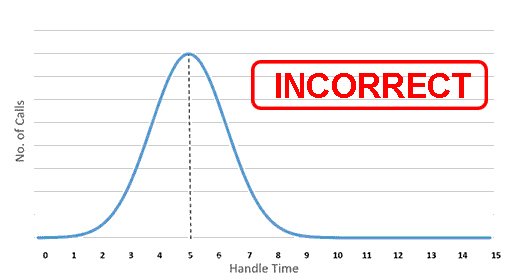
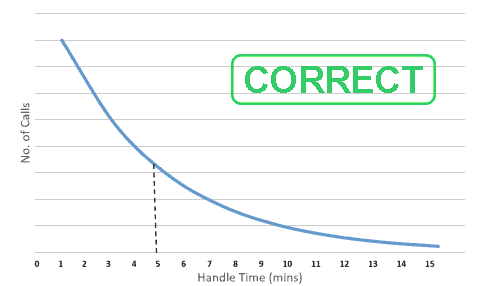
While we often assume a bell curve forms around our averages, what you will find is that we receive loads and loads of short calls, with a few very long calls.
While we often assume a bell curve forms around our averages, what you will find is that we receive loads and loads of short calls, with a few very long calls.
John Casey draws on his own, recent project with a large retail company to say: “For every ten calls that lasted for just one or two minutes, there was always one that was 15, 30 or even 60 minutes long, because the customer had such a severe issue.”
“So, we need to accept this is how contacts arrive and then identify what sort of calls are those one- or two-minute calls and which call types tend to take a lot longer, and go back to thinking about why somebody wanted to call us that day.”
By considering this question, we can assess how the distribution of our AHT changes in certain scenarios. So, if we predict a scenario which causes a large number of calls with longer AHTs to come in, when we schedule for these scenarios, this rise in AHT needs to be accounted for.
Don’t fall into the trap of thinking that each of the calls that we receive is entirely random. While they are random to a point, there are trends out there and other things going on.
These other things can include marketing campaigns, viral news articles and stories about your competitors which draw contacts into the contact centre in a different way.
Everyone has a reason to make that call – we need to regularly put ourselves in the shoes of the customers and try to identify those reasons.
For more information on this topic, read our article: How Is Average Handling Time (AHT) Distributed? It Is Not How you Think!
What Else Causes a Variance in AHT?
As a final point on the variance in handle times, we also need to remember how the AHT changes according to other factors like time of the day.
In fact, it is a general principle that, in most contact centres:
AHT is low at the start of the day – This is because customers want to get things done before they get on with their day.
AHT rises around lunch time – This is because customers are likely on their lunch break, deliberately setting aside a healthy amount of time to fully engage in the conversation.
AHT reduces at the end of the day – This is because advisors often rush through their calls at the end of their shift, while customers may also be aware of the time at which the contact centre closes.
But don’t just take our word for it. Look at your own contact centre data and see if our percentages are similar to what you are seeing. If so, it is important to be aware of these patterns in AHT across the day.
For more information to improve resource planning in your contact centre, read these articles next:
- Seasonal WFM – How to Prepare for Peaks and Troughs in Contact Volumes
- Preparing for the Unexpected: How to Create a Business Continuity Plan
- How Far in Advance Should You Publish Your Contact Centre Shifts?
Author: Charlie Mitchell
Reviewed by: Robyn Coppell
Published On: 28th Aug 2019 - Last modified: 19th Aug 2025
Read more about - Workforce Planning, Editor's Picks, Forecasting, John Casey, Real-Time Management, Scheduling, Workforce Management (WFM), Workforce Planning















